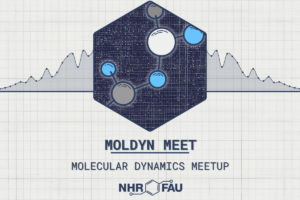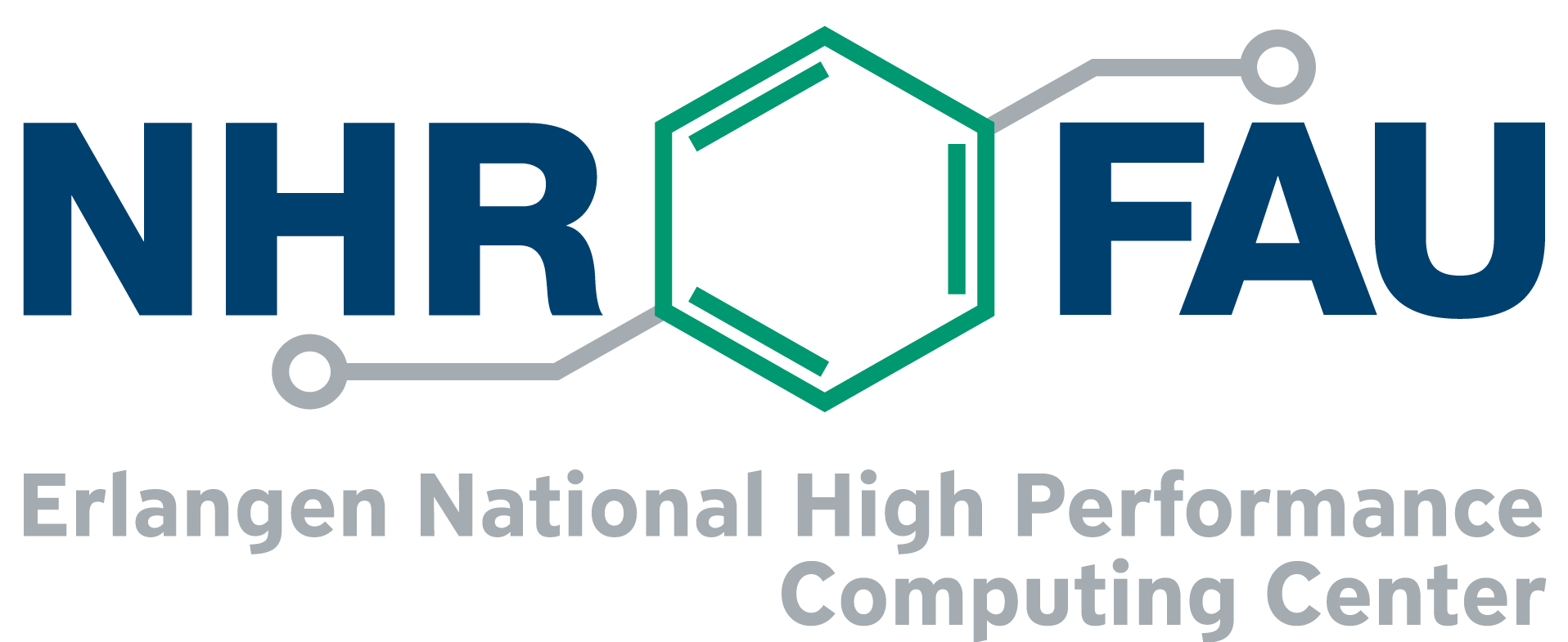NHR@FAU Liaison Scientists
Overview of the Liaison Scientists
NHR@FAU PI: Prof. Dr. Petra Imhof, Professorship for Computational Chemistry, Computer-Chemistry-Center, and NHR@FAU
NHR activities, projects, and support
Frank Beierlein has benchmarked and tested Amber20 on the new RTX 3080 (TinyGPU) and Tesla A40 (Alex) GPUs, in addition to local GPUs (RTX A5000). As the new clusters use Slurm instead of torque as batch system, the submit scripts for different types of Amber jobs were adapted for Slurm. Frank watches the Amber list and the Amber literature to ensure being up-to-date with what happens in the Amber community.
Frank optimized the setup of Amber20 free energy thermodynamic integration simulations for efficient use of the new GPU cluster Alex (and the new nodes on TinyGPU) in tandem with Thomas Zeiser from the Systems & Services group of NHR@FAU. In his current research on DNA repair mechanisms, Frank develops high-quality parameters for damaged DNA bases which are part of a DNA strand that binds to a DNA repair enzyme. He adapted and refined the setup, simulation and analysis process for simulations in the field of alchemistic free energy methods, like thermodynamic integration, so that these simulations can now be run routinely on the NHR@FAU HPC clusters employing NVIDIA’s MPS server. Moreover, Frank optimized the the process of analyzing DNA/protein MD simulations and free energy simulation. He takes care that documentation, scripts, and inputs are as user-friendly as possible ensuring that even inexperienced users can apply advanced simulation techniques on HPC systems.
Teaching and training
Frank is closely involved in teaching computational chemistry courses/hands on user training for the FAU students at the Computer-Chemistry-Center (CCC): Moderne Softwareapplikationen, Molecular Modeling, Computational Chemistry, Bio-Organic & Bio-Inorganic LAB and Drug Discovery LAB.
NHR@FAU PI: Prof. Dr. Heinrich Sticht, Professorship for Bioinformatics, and NHR@FAU
NHR activities, projects, and support
Anselm Horn was granted an early-user-access for the new clusters Alex (GPU) and Fritz (CPU) in order to test the large number of A40 cards in simulations. The project aimed at investigating the feasibility of modelling the binding of a ligand to a single chain antibody fragment (scFv); for that, many different initial ligand orientations in the simulation setup ensured truly independent simulation runs. Since this project was the first larger-scale application of Amber on Alex and Fritz, the experience gained is most valuable for HPC users and NHR@FAU projects.
Using his expertise on Amber force field parameterization, Anselm developed 14SB-compatible parameters for a PEG3 and a PEG6 spacer unit. In conjunction with earlier developed parameters for isopeptide bonds, he was able to investigate the dynamics of a covalently coupled PEG-containing peptide linker around insulin-like growth factor using the A100 GPU cards of TinyGPU.
Anselm is actively involved in the Amber Mailing List helping Amber users all over the world to overcome problems, especially in the area of parameter generation. In addition, he is interested in Research Data Management for data from Molecular Dynamics simulations.
Teaching and training
In order to provide a first help for new users, Anselm works on an extension of the Tips & Ticks section for Amber with focus on practical aspects with regard to the new compute clusters Alex and Fritz.
NHR@FAU PI: Prof. Dr. Peter Uhrig, Chair of Big Data Linguistics, and NHR@FAU
NHR activities, projects, and support
Armine Garibyan has experience in rule-based gesture detection within large video data repositories, utilizing the Woody cluster (CPU) for computational efficiency. She has also trained LoRa adapters and conducted full fine-tuning of large language models (LLMs) for linguistics tasks using the Alex cluster (GPU). Her main areas of expertise include video data analysis, LLM development, the application of machine learning in computational linguistics.
Teaching and training
Armine is particularly enthusiastic about supporting researchers with an academic background in the humanities to set up experiments on HPC clusters.
NHR@FAU PI: Prof. Dr. Rainer Böckmann, Professorship for Computational Biology, and NHR@FAU
NHR activities, projects, and support
Marius Trollmann took an active part in the test phase of the recently established GPU cluster Alex at NHR@FAU. He provided a wide-range set of systems to analyze the performance of the simulation software GROMACS on the available A40 and A100 GPUs. These results help Gromacs users at NHR@FAU to get a reliable estimation of their required computation time, to achieve reliable results at a reasonable time scale, and will further help potential users to exploit their granted resources more efficiently.
One of his projects approaches the toxicity of hundreds of antimicrobial peptides (AMPs) against red blood cells in a high-throughput method. The huge number of simulation systems requires the extensive optimized use of multiple GPUs. Another project considers the study of mRNA-based vaccines: Approximately 28,500 GPU-hours were spent to characterize the structure and the physico-chemical properties of the lipid nanoparticles (LNPs) used in the BioN-Tech&Pfizer vaccine employing classical molecular dynamics (MD) simulations. The computationally demanding atomistic simulations of the LNPs with a size between three and seven Mio atoms requires extensive use of multiple A40 and A100 GPUs.
Teaching and training
Marius is involved in the master module Orientierungsmodul Strukturbiologie I and Orientierungsmodul Strukturbiologie II where participants get in touch with a realistic research hypothesis for which they then prepare and perform own simulations. He also contributes to the practical part of the module Molecular Dynamics Simulation of Biological Membranes which deals in particular with the programming of a simple MD-Engine employing Python and the application of free-energy calculations with Gromacs.
NHR@FAU PI: Prof. Dr. Andreas Görling, Chair of Theoretical Chemistry, and NHR@FAU
NHR Activities, projects, and support
Egor Trushin performed benchmark tests of GPU-accelerated Vienna Ab initio Simulation Package (VASP) on TinyGPU and Alex GPGPU clusters. Performance for various computational setups was analysed including various GPU models and number of used GPUs. Comparison with the CPU-executed version was also done. Moreover, he participated in the development and implementation of new quantum chemistry and density functional methods in the Molpro quantum chemistry package. Egor’s main areas of expertise are electronic structure calculations for molecules and solids, code development with Python and FORTRAN, and parallel programming using openMP und MPI.
Molecular Dynamics Meetup (MolDyn Meet)
 Join the Molecular Dynamics Meetup hosted by NHR@FAU on the first Wednesday of every month from 11am to 12am. Our liaison scientists will be available to assist with optimizing the performance of your MD simulations, troubleshooting simulation setups, and providing guidance on basic analysis techniques. Support focuses on the primary simulation software packages used on our systems: GROMACS, Amber, LAMMPS, and NAMD.
Join the Molecular Dynamics Meetup hosted by NHR@FAU on the first Wednesday of every month from 11am to 12am. Our liaison scientists will be available to assist with optimizing the performance of your MD simulations, troubleshooting simulation setups, and providing guidance on basic analysis techniques. Support focuses on the primary simulation software packages used on our systems: GROMACS, Amber, LAMMPS, and NAMD.
If you have specific topics you’d like to explore in detail, please fill out our form (https://go-nhr.de/molecular-dynamics-meetup-request) to ensure we can address your needs more effectively during the session. However, you can join also without asking questions in advance.
Please note that this service is limited to technical support; we do not provide scientific advice on specific biological or materials science topics.
The meeting will be held online via Zoom: https://go-nhr.de/moldynmeet
Next meetups: June 4, July 2 (at 11am)
For more information, visit hpc.fau.de or contact support-hpc@fau.de.
